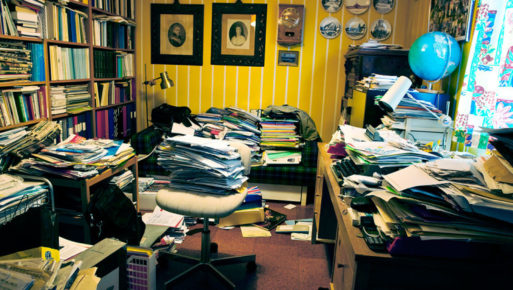In Sweden, the people have an expression — “dostadning.” The word translates to the words death and cleaning, or death cleaning for short. It refers to the practice of middle-aged and elderly people cleaning out their homes so that their family and friends need not be burdened with the task after they die.
Paper Trail
There are several ways to do a death cleaning. One is to throw out all unneeded paperwork. My father was something of a paper hoarder. He kept copies of letters that he had written decades ago, and if there was a reply, he stapled it to the original letter. After he died, we had to go through each and every piece of paper to see if it should be retained or discarded.

Credit: wrappedinrust.com
But suppose you want to keep your correspondence with your friends and family for reference, or just for a trip down memory lane? In that case, set aside two boxes. Label one as “Discard” and one as “Keep.” The “Discard” box is made up of all the personal letters; tell your family they can throw them away when you’re gone. The “Keep” box consists of current documents that your family will need after your death, such as proof of homeowners insurance and deeds.
If there aren’t any papers you really want to keep, set aside a day or two, sort through all of them, and throw away everything that you don’t absolutely need. If you’re not sure whether it’s okay to toss a paper, check with your attorney.
Clothes and Jewelry
Go to your closet and pick out the clothes that are out of style, don’t fit any more, or that you just plain don’t like. The ones still in the closet are the keepers. There are many things you can do with your leftovers. Give them to your grandkids to play dress-up with. Give them to family members who will appreciate and wear them. Donate them to the nearest thrift shop. Whatever you do, get them out of your house.
Jewelry is a little trickier because it can be valuable jewelry or costume jewelry. If you’re going to get rid of some of your jewelry, have it appraised. A jewelry shop will often do that, and some stores will even send an appraiser out to the home. Then you can decide whether to sell the items, keep them, or give them away. For instance, my grandmother was trying to cut back on the items in her house. She had some beautiful sparkling costume jewelry. She let me and my two older sisters choose one piece each. The one I chose was a bright red. I still have it.
Broaching the Subject
When you’re dealing with your own things, you generally have a pretty good idea of when you should start clearing out the things you don’t need anymore. But what if you’re dealing with a parent or grandparent who really needs to do some death cleaning? The first step is tact. Your loved one may find the term death cleaning frightening or offensive.

Credit: assisted-living-directory.com
Instead, you might start dropping hints about downsizing. If your loved one is planning to move to an assisted living facility or nursing home, you could point out that there won’t be room in these new living spaces for all your loved one things. Another method might be to say something like, “Mom, I hope you’re around forever, but in case you’re not, I don’t have the slightest idea what to do with all the things you’ll leave behind. Remember how you struggled with getting rid of Dad’s belongings?”
Death cleaning is a kindness to your family, and going through your things may bring back long forgotten, fond memories as well.
For more information about dostadning, check out “The Gentle Art of Swedish Death Cleaning: How to Free Yourself and Your Family from a Lifetime of Clutter” by Margareta Magnusson.

 Death Cleaning: A Thoughtful Act for Family and Friends
Death Cleaning: A Thoughtful Act for Family and Friends



 “As Tears Go By” by Marianne Faithfull
“As Tears Go By” by Marianne Faithfull
 “The Sea” by John Banville
“The Sea” by John Banville














